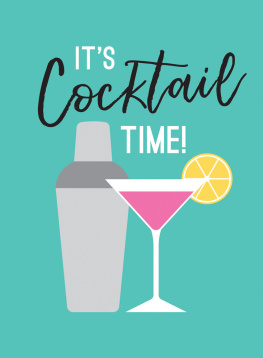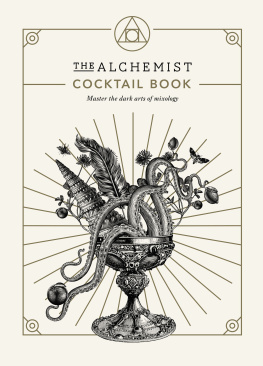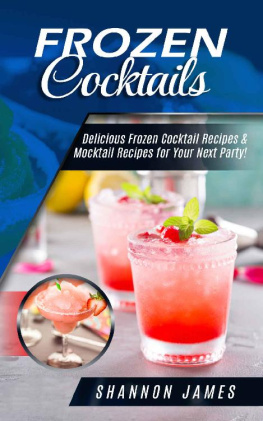ITS COCKTAIL TIME! This updated edition copyright Summersdale Publishers Ltd, 2018 First published in 2014 as The Little Book of Cocktails All rights reserved. No part of this book may be reproduced by any means, nor transmitted, nor translated into a machine language, without the written permission of the publishers. Condition of Sale
This book is sold subject to the condition that it shall not, by way of trade or otherwise, be lent, resold, hired out or otherwise circulated in any form of binding or cover other than that in which it is published and without a similar condition including this condition being imposed on the subsequent purchaser. An Hachette UK Company
www.hachette.co.uk Summersdale Publishers Ltd
Part of Octopus Publishing Group Limited
Carmelite House
50 Victoria Embankment
LONDON
EC4Y 0DZ
UK www.summersdale.com eISBN: 978-1-78685-840-5 Substantial discounts on bulk quantities of Summersdale books are available to corporations, professional associations and other organisations. For details contact general enquiries: telephone: +44 (0) 1243 771107 or email: . To.......................................
From....................................  Contents What is a cocktail? The official definition of a cocktail, according to the modern Merriam-Webster dictionary, is a usually iced drink of wine or distilled liquor [spirit] mixed with flavouring ingredients. Strictly speaking, a cocktail should be any drink that contains two or more ingredients, with at least one of those ingredients being alcohol. When a cocktail contains only a distilled spirit and a liqueur it is a duo; when you add a mixer its a trio. Additional ingredients in cocktails could be any type of fruit, sugar, syrup, honey, milk or cream, or various herbs and spices.
Contents What is a cocktail? The official definition of a cocktail, according to the modern Merriam-Webster dictionary, is a usually iced drink of wine or distilled liquor [spirit] mixed with flavouring ingredients. Strictly speaking, a cocktail should be any drink that contains two or more ingredients, with at least one of those ingredients being alcohol. When a cocktail contains only a distilled spirit and a liqueur it is a duo; when you add a mixer its a trio. Additional ingredients in cocktails could be any type of fruit, sugar, syrup, honey, milk or cream, or various herbs and spices.  History of cocktails Theres a debate about where the word cocktail comes from.
History of cocktails Theres a debate about where the word cocktail comes from.  History of cocktails Theres a debate about where the word cocktail comes from.
History of cocktails Theres a debate about where the word cocktail comes from.
The first written references date back to the late eighteenth and early nineteenth centuries, including an 1803 article in a New England publication, The Farmers Cabinet , where a man says he drank a glass of cocktail excellent for the head. Some claim that a female innkeeper in America during the revolutionary war decorated some drinks with the tail feathers of her English neighbours chicken, which she had just cooked and served to American and French soldiers. This bold move was cheered on by her patrons, who raised their glasses to the words of Vive le cocktail! Another story claims that the name derives from the French word coquetier , meaning egg cup, as a Frenchman in New Orleans was said to have served a medicinal mixed drink in egg cups in the early 1800s. The cocktails we know and love today really all started when Prohibition was introduced in the USA in 1920. The banning of alcohol led to illegal alcohol factories springing up everywhere. Most of the spirits produced in these factories tasted awful and were sometimes even poisonous! During this time, speakeasies illicit bars became very popular, as the bartenders would often mix alcohol with a number of other ingredients like cream or juice both to hide it from the police and to disguise the unpleasant taste of the poor-quality alcohol.
Inevitably, mixed drinks and cocktails soared in popularity. Whatever the words origins really are, theres no doubt that the cocktail has played a big role in American social history. After Prohibition ended in 1933, bartenders and mixologists were free to really experiment with spirits and liqueurs, and the popularity of cocktails continues to this day. From sweet, tropical blends to modern-day craft cocktails containing novel ingredients and complex flavours, it seems we cant get enough of them. With a trend towards greater refinement in drinking culture, cocktails have now become a central theme for a night out rather than just part of one.  The Equipment youll need If you feel overwhelmed at the thought of trying to recreate cocktails at home that you may have enjoyed in a bar, dont be.
The Equipment youll need If you feel overwhelmed at the thought of trying to recreate cocktails at home that you may have enjoyed in a bar, dont be.  The Equipment youll need If you feel overwhelmed at the thought of trying to recreate cocktails at home that you may have enjoyed in a bar, dont be.
The Equipment youll need If you feel overwhelmed at the thought of trying to recreate cocktails at home that you may have enjoyed in a bar, dont be.
Mixing up some great cocktails is not actually as hard as it looks if you invest in the right tools and it can be a lot of fun! COCKTAIL SHAKER There are a number of different shakers to choose from, including the French style, Boston shaker and Cobbler. The bartenders favourite tends to be the Boston shaker.  FOOD PROCESSOR OR BLENDER Useful if you want to make frozen cocktails or smoothies.
FOOD PROCESSOR OR BLENDER Useful if you want to make frozen cocktails or smoothies.  BAR SPOON A metal spoon with a long, often twisted, shaft.
BAR SPOON A metal spoon with a long, often twisted, shaft.  JIGGER A two-sided shot measurer; one end holds up to 25 ml and the other 50 ml.
JIGGER A two-sided shot measurer; one end holds up to 25 ml and the other 50 ml.  MUDDLER A stirring rod, usually metal, with a ridged circular end that is used for crushing solid ingredients.
MUDDLER A stirring rod, usually metal, with a ridged circular end that is used for crushing solid ingredients.  FINE STRAINER An item similar to an everyday kitchen sieve, only smaller and with finer holes.
FINE STRAINER An item similar to an everyday kitchen sieve, only smaller and with finer holes.  ICE BUCKET (IF YOURE HOSTING A BIG PARTY) Whenever its cocktail time, ensure you have plenty of ice.
ICE BUCKET (IF YOURE HOSTING A BIG PARTY) Whenever its cocktail time, ensure you have plenty of ice.  ICE BUCKET (IF YOURE HOSTING A BIG PARTY) Whenever its cocktail time, ensure you have plenty of ice.
ICE BUCKET (IF YOURE HOSTING A BIG PARTY) Whenever its cocktail time, ensure you have plenty of ice.
No one wants tepid drinks! Using ice is required for all the recipes in the book, so make sure you stock up.  LEMON AND LIME SQUEEZER
LEMON AND LIME SQUEEZER  Varieties of cocktail glasses Avoid a cocktail party faux pas by ensuring you have the appropriate glass for the drinks you serve. Heres a brief guide THE COCKTAIL (OR MARTINI) GLASS Ideal for: varieties of Martinis such as Vodka Martinis and many classic cocktails such as Manhattans.
Varieties of cocktail glasses Avoid a cocktail party faux pas by ensuring you have the appropriate glass for the drinks you serve. Heres a brief guide THE COCKTAIL (OR MARTINI) GLASS Ideal for: varieties of Martinis such as Vodka Martinis and many classic cocktails such as Manhattans.  THE HIGHBALL AND COLLINS GLASSES Ideal for: tall mixed drinks or Highballs, such as gin and tonic. These drinks are generally built in the glass and poured over ice.
THE HIGHBALL AND COLLINS GLASSES Ideal for: tall mixed drinks or Highballs, such as gin and tonic. These drinks are generally built in the glass and poured over ice. 









 Contents What is a cocktail? The official definition of a cocktail, according to the modern Merriam-Webster dictionary, is a usually iced drink of wine or distilled liquor [spirit] mixed with flavouring ingredients. Strictly speaking, a cocktail should be any drink that contains two or more ingredients, with at least one of those ingredients being alcohol. When a cocktail contains only a distilled spirit and a liqueur it is a duo; when you add a mixer its a trio. Additional ingredients in cocktails could be any type of fruit, sugar, syrup, honey, milk or cream, or various herbs and spices.
Contents What is a cocktail? The official definition of a cocktail, according to the modern Merriam-Webster dictionary, is a usually iced drink of wine or distilled liquor [spirit] mixed with flavouring ingredients. Strictly speaking, a cocktail should be any drink that contains two or more ingredients, with at least one of those ingredients being alcohol. When a cocktail contains only a distilled spirit and a liqueur it is a duo; when you add a mixer its a trio. Additional ingredients in cocktails could be any type of fruit, sugar, syrup, honey, milk or cream, or various herbs and spices.  The Equipment youll need If you feel overwhelmed at the thought of trying to recreate cocktails at home that you may have enjoyed in a bar, dont be.
The Equipment youll need If you feel overwhelmed at the thought of trying to recreate cocktails at home that you may have enjoyed in a bar, dont be.  FOOD PROCESSOR OR BLENDER Useful if you want to make frozen cocktails or smoothies.
FOOD PROCESSOR OR BLENDER Useful if you want to make frozen cocktails or smoothies.  BAR SPOON A metal spoon with a long, often twisted, shaft.
BAR SPOON A metal spoon with a long, often twisted, shaft.  JIGGER A two-sided shot measurer; one end holds up to 25 ml and the other 50 ml.
JIGGER A two-sided shot measurer; one end holds up to 25 ml and the other 50 ml.  MUDDLER A stirring rod, usually metal, with a ridged circular end that is used for crushing solid ingredients.
MUDDLER A stirring rod, usually metal, with a ridged circular end that is used for crushing solid ingredients.  FINE STRAINER An item similar to an everyday kitchen sieve, only smaller and with finer holes.
FINE STRAINER An item similar to an everyday kitchen sieve, only smaller and with finer holes.  ICE BUCKET (IF YOURE HOSTING A BIG PARTY) Whenever its cocktail time, ensure you have plenty of ice.
ICE BUCKET (IF YOURE HOSTING A BIG PARTY) Whenever its cocktail time, ensure you have plenty of ice.  LEMON AND LIME SQUEEZER
LEMON AND LIME SQUEEZER  Varieties of cocktail glasses Avoid a cocktail party faux pas by ensuring you have the appropriate glass for the drinks you serve. Heres a brief guide THE COCKTAIL (OR MARTINI) GLASS Ideal for: varieties of Martinis such as Vodka Martinis and many classic cocktails such as Manhattans.
Varieties of cocktail glasses Avoid a cocktail party faux pas by ensuring you have the appropriate glass for the drinks you serve. Heres a brief guide THE COCKTAIL (OR MARTINI) GLASS Ideal for: varieties of Martinis such as Vodka Martinis and many classic cocktails such as Manhattans.  THE HIGHBALL AND COLLINS GLASSES Ideal for: tall mixed drinks or Highballs, such as gin and tonic. These drinks are generally built in the glass and poured over ice.
THE HIGHBALL AND COLLINS GLASSES Ideal for: tall mixed drinks or Highballs, such as gin and tonic. These drinks are generally built in the glass and poured over ice. 